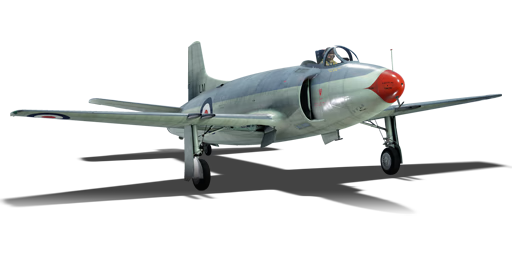



As an attempt to replace the Spitfire, Supermarine created the Spiteful fighter with redesigned wings and undercarriage. However, with the advent of jet engine development, piston-engined aircraft were beginning to be overlooked for better performing aircraft. To save the project, Supermarine offered to convert the aircraft into a jet-powered version and also adapting it for the Royal Navy, who were also looking for a new jet-powered aircraft. Following successful redesign and testing, the new jet was accepted into production as the Attacker. Originally designed as a fighter with designation Attacker F.1, 11 of the last production units were converted into a fighter-bomber version designated Attacker FB.1.
Introduced in Update 1.49 "Weapons of Victory", the Attacker FB.1 follows the Sea Fury in the Fleet Air Arm branch and is the first operational carrier-based jet in the Royal Navy's arsenal. The design allows for a multi-role function between fighting in the air or ground. The Attacker is the only British jet from its period to feature wing-mounted cannon armament. Unlike other British jet fighters that adopt nose-mounted configurations, the 4 x 20 mm Hispano Mk V cannons on the Attacker do require careful use of convergence as a result of their positioning, much like the Sea Fury and Seafires. The Attacker can also mount 2 bombs and or 12 rockets. This combined with the universal or ground targets belts allows the Attacker to live up to its namesake, should pilots choose to use it in a fast ground-attack fighter-bomber role.
flaps
flaps
flaps
brake
| Belt | Belt filling | Armor penetration (mm) at a distance: | |||||
|---|---|---|---|---|---|---|---|
| 10 m | 100 m | 500 m | 1000 m | 1500 m | 2000 m | ||
| HEI/SAP-I/T | 21 | 19 | 14 | 9 | 5 | 4 | |
| AP-T/HEI/SAP-I | 36 | 33 | 24 | 15 | 10 | 7 | |
| SAP-I/HEI/AP-T/HEI/SAP-I | 36 | 33 | 24 | 15 | 10 | 7 | |
| AP-T/HEI/T | 36 | 33 | 24 | 15 | 10 | 7 | |
| AP-T/SAP-I/HEI/AP-T | 36 | 33 | 24 | 15 | 10 | 7 | |
| HEI/SAP-I | 22 | 20 | 14 | 9 | 6 | 4 | |
6 × RP-3 rockets












Flight performance | |
|---|---|
Survivability |
|---|
Weaponry | |
|---|---|